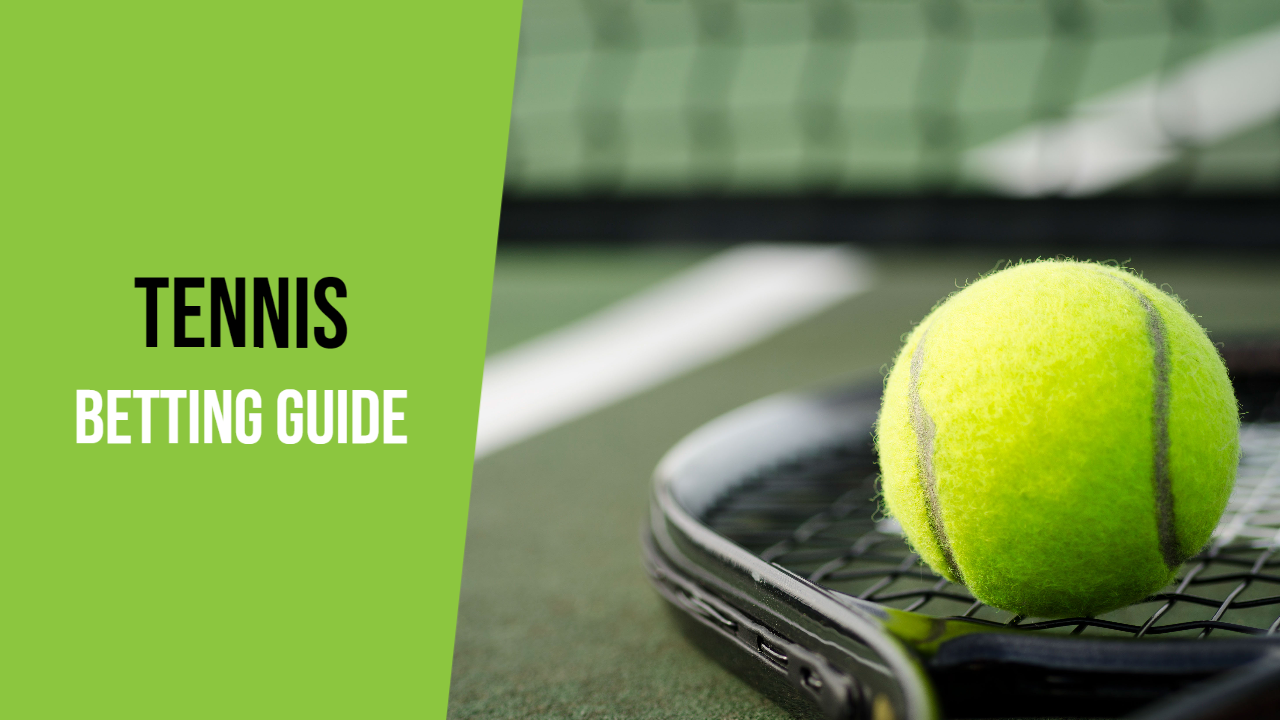
This tennis betting guide explores how the sport works, what factors affect match outcomes, and how to approach betting decisions with more insight. It also highlights useful resources to help you analyse matches and improve your overall strategy.
About Tennis Betting
Tennis betting involves wagering on the outcome of tennis matches or specific elements within a match — such as the winner of a set, the number of games played, or the exact score. Bets can be placed pre-match or live in-play.
The sport’s appeal lies in its fast pace, strategic depth, and global calendar. With matches played year-round, tennis offers near-constant opportunities to follow form and spot potential value. Unlike team sports, you’re usually betting on the performance of a single athlete — which can reduce unpredictability if you’ve done your research.
Why Bet on Tennis?
-
Consistency at the Top
Tennis has a relatively small pool of elite players who dominate the top rankings. This makes high-level matches more predictable than in many team sports.
-
In-play Opportunities
Momentum shifts quickly in tennis, creating opportunities for live betting. Markets often react slowly to key points — giving an edge to alert bettors.
-
Familiar Formats
Many bettors already understand how tennis works — sets, games, tie-breaks, etc. This lowers the barrier to entry compared to more niche sports.
Popular Tennis Competitions
The most prestigious events in tennis are the Grand Slam tournaments, listed below:
- Wimbledon – Played on grass in London (June–July), Wimbledon is the oldest and most iconic tennis tournament in the world. It’s widely regarded as the sport’s crown jewel.
- French Open (Roland Garros) – Held on clay in Paris (May–June), it’s the most physically demanding Slam and a true test of endurance and tactical skill.
- US Open – A hard-court Grand Slam staged in New York (August–September), known for its rowdy crowds, night matches, and high-paced conditions.
- Australian Open – Played on hard courts in Melbourne (January), it kicks off the tennis calendar and often produces unpredictable early-season results.
Other key tournaments include:
- ATP Finals – A year-end event featuring the top eight men’s singles players and doubles teams.
- Davis Cup – The leading men’s international team competition, organised by the ITF.
- Billie Jean King Cup – The premier women’s international team competition, formerly known as the Fed Cup.
Best Bookmakers for Tennis Betting
When it comes to betting on tennis, the following bookmakers stand out for offering strong coverage, competitive odds, and a good range of markets
#ad. 18+, GambleAware.org, T&Cs Apply
#ad. 18+, GambleAware.org, T&Cs Apply
#ad. 18+, GambleAware.org, T&Cs Apply
#ad. 18+, GambleAware.org, T&Cs Apply
#ad. 18+, GambleAware.org, T&Cs Apply
#ad. 18+, GambleAware.org, T&Cs Apply
#ad. 18+, GambleAware.org, T&Cs Apply
#ad. 18+, GambleAware.org, T&Cs Apply
Considerations for Tennis Betting
Successful tennis betting requires more than just backing the top-ranked player. Like any individual sport, outcomes are shaped by a complex mix of physical, technical, tactical, and psychological factors. Here are the key elements worth analysing before placing your bets.
Player Form
A player’s recent form is one of the strongest indicators of current performance level. Rankings often lag behind — so form helps you spot up-and-coming players or fading favourites.
Key stats to consider:
- First/Second serve win % – Gauges how reliably a player holds serve under pressure
- Break point conversion – Indicates ability to seize crucial chances
- Unforced vs. forced errors – Reveals how much pressure a player is applying or absorbing
- Service games won – Good indicator of dominance, especially on faster surfaces
- Recent match duration – Long matches or tight schedules can lead to fatigue
Tip: Don’t just look at wins — assess the quality of opposition and surface relevance too.
Playing Surface
Head-to-head stats reveal how well players match up — beyond rankings or form.
Why it matters:
- Confidence – Players often perform better against opponents they’ve beaten before
- Tactical edge – Prior meetings can expose exploitable patterns
- Mental block – Some rivalries create clear psychological advantages
- Surface-specific H2H – A player might dominate on hard courts but struggle on clay
Tip: Check H2H recency — older wins may not reflect current ability.
Head-to-Head (H2H) Records
The playing surface is a key component in tennis performance and can have a significant impact on the outcome of a match in the following ways:
- Speed: Different surfaces have different speeds of play. Hard courts are generally faster, while clay courts are slower.
- Bounce: The type of surface affects the height and consistency of the ball’s bounce. Grass courts produce a low and unpredictable bounce, while clay courts produce a high and consistent bounce.
- Sliding: Some surfaces allow players to slide, while others make sliding difficult. This affects player movement and shot selection.
- Spin: The type of surface affects the amount of spin a player can generate on their shots. Clay courts tend to produce more spin, while hard courts produce less.
- Wear and tear: Some surfaces wear out faster than others, which can affect play over the course of a match or tournament.
- Player style: Certain playing styles are more suited to specific surfaces. For example, players who rely on sliding and generate a lot of spin may perform better on clay courts.
Physical Fitness
Tennis is physically punishing — especially over long tournaments. Fitness influences performance over both points and matches.
What to look for:
- Endurance – Needed for recovery between matches and long rallies
- Speed & agility – Affects ability to defend and recover
- Strength – Influences serve power and shot aggression
- Recent injuries or niggles – Even minor issues can tilt the balance
- Time on court – Excessively long matches can cause fatigue in later rounds
Players returning from injury or showing visible fatigue are generally poor value unless heavily discounted.
Mental State
Tennis players face long periods of solo focus — and mental resilience is crucial, particularly in close matches.
Key traits:
- Composure – Can they handle pressure in tie-breaks and break points?
- Confidence – Recent success boosts risk-taking and aggression
- Focus – A lapse in concentration can quickly cost a game or set
- Emotional control – Players prone to frustration often rack up unforced errors
Players known for choking in big moments or reacting poorly to adversity are worth opposing in tight matchups.
Injuries & Fatigue
Fitness news isn’t always public, but it plays a huge role in match outcomes.
Warning signs:
- Recent withdrawals or retirements
- Medical timeouts in previous matches
- Slow movement or dropped serve speed
- Playing back-to-back tournaments or late-night matches
Tip: Lower-profile injuries or general fatigue are more likely to affect performance over five-set formats.
Weather Conditions
In outdoor events, weather can shape both the playing conditions and the player’s comfort level.
- Heat & humidity – Increase fatigue and reduce stamina
- Wind – Disrupts rhythm, particularly on serve and overhead shots
- Rain delays – Interrupt flow and benefit mentally composed players
- Altitude – Higher venues (e.g. Madrid) make the ball fly faster, favouring aggressive styles
Tip: Check local conditions — they vary more than many bettors assume, especially in early-season tournaments.
Tennis Betting Markets
Tennis is a popular sport to bet on and there are a variety of markets that players can wager on. Some of the most popular tennis betting markets include:
- Winner: A bet on which player will win the match.
- Total games: A bet on the total number of games played in the match.
- Handicap: A bet in which a virtual advantage is given to the underdog to level the playing field.
- Set betting: A bet on which player will win a specific set.
- Correct score: A bet on the exact score of the match.
- To win a specific number of games in a set: A bet on the number of games a player will win in a specific set.
- Total sets: A bet on the total number of sets played in the match.
Best Sites for Tennis Stats
Useful websites for tennis stats and analyses include:
Explore in detail: Best Sites For Free Tennis Statistics
Best Tennis Tipsters
Here are the top-rated tennis tipsters, based on verified performance. Full details available in: Best Tennis Tipsters.
| Rank | Star Rating | Tipster | Proofed By | Established | Tips | Average Odds | All-time Profit | All-time ROI | (+/-) Units | 3-Month Profit | 3-Month ROI | (+/-) Units | Est. Weekly Tips | Usual Publishing Times | Trial Period | Monthly Cost | |
|---|---|---|---|---|---|---|---|---|---|---|---|---|---|---|---|---|---|
| 1 | 3.8 | iTennis | Tipstrr | February 2018 | 3,287 | 2.10 | £720.91 | 2.20% | +72 | £120.90 | 6.00% | +12 | 10 | 8am-12pm & 8pm-12am | £5.70 for 30 days | £19 | |
| 2 | 3.6 | The Jackpot Junkie Tennis | Tipstrr | May 2023 | 494 | 3.29 | £770.90 | 15.60% | +77 | £129.80 | 13.20% | +13 | 10 | 8am-12pm & 8pm-12am | £9.50 for 30 days | £19 | |
| 3 | 3.6 | All Value | Tipstrr | January 2022 | 360 | 2.24 | £292.90 | 8.10% | +29 | £184.00 | 11.30% | +18 | 3 | Throughout the day | £5.70 for 30 days | £19 | |
| 4 | 3.6 | Ottchen – Tennis | Tipstrr | February 2022 | 986 | 2.44 | £417.00 | 4.20% | +42 | £168.40 | 5.10% | +17 | 9 | 8pm-12am | FREE | FREE | |
| 5 | 3.6 | Anna-nass | Tipstrr | August 2022 | 656 | 2.90 | £309.20 | 4.70% | +31 | £285.20 | 26.20% | +29 | 7 | 8am-12pm | £19.50 for 30 days | £39 | |
| 6 | 3.5 | BRTennis | Tipstrr | October 2021 | 965 | 1.86 | £277.70 | 2.90% | +28 | £14.60 | 4.20% | +1 | 7 | 8am-12pm | £5.70 for 30 days | £19 | |
| 7 | 3.5 | Parlay.fx | Tipstrr | January 2024 | 70 | 1.68 | £70.50 | 10.10% | +7 | £87.90 | 18.70% | +9 | 5 | 8am-12pm & 8pm-12am | FREE | FREE | |
| 8 | 3.4 | Tennisinvestor | Tipstrr | January 2024 | 262 | 2.50 | £156.50 | 6.00% | +16 | £156.50 | 6.00% | +16 | 18 | 8am-4pm | FREE | FREE |
Tennis FAQ
Tennis is scored in four levels: points, games, sets, and matches.
➤ Points in a game:
- Love = 0
- 15 = first point won
- 30 = second point
- 40 = third point
- Game = fourth point (if leading by two)
If the score reaches 40–40, it’s called deuce. A player must win two consecutive points from deuce to win the game.
➤ Games in a set:
The first player to win six games with a two-game margin wins the set (e.g. 6–3). If the score reaches 6–6, a tie-break usually decides the set.
➤ Sets in a match:
- Most matches are best of three sets
- Men’s Grand Slam matches are best of five
The player who wins the majority of sets wins the match.
Deuce is a tie at 40–40 in a game. From this point:
- The next point is called advantage
- If the player with advantage wins the next point, they win the game
- If they lose it, the score returns to deuce
This continues until one player wins two consecutive points to secure the game.
A tie-break is played when the score in a set reaches 6–6. Players alternate serves, and the first to reach 7 points with a 2-point margin wins the set. Tie-breaks can be unpredictable and often favour mentally strong players with consistent serves.
If a player retires mid-match, most bookmakers will void the bet if the match hasn’t been completed, especially in accumulator bets. Some may settle markets differently based on how many sets or games were played. Always check your bookmaker’s tennis rules.
Tip: This is especially important when betting on players with recent injuries or known fitness concerns.
The four Grand Slam events are the most prestigious in tennis. They are:
- Wimbledon – Grass court, UK (June–July)
- French Open – Clay court, France (May–June)
- US Open – Hard court, USA (August–September)
- Australian Open – Hard court, Australia (January)
These tournaments offer the most ranking points, media coverage, and betting interest.
- ATP (Association of Tennis Professionals) runs the men’s professional tour
- WTA (Women’s Tennis Association) runs the women’s professional tour
Both organisations rank players, run tournaments, and oversee their respective global tours.
Tennis betting shouldn’t be viewed as a reliable way to make money. Like all forms of sports betting, it carries risk, and most casual bettors lose in the long run.
That said, you can improve your chances by:
- Studying player form and surface preferences
- Using head-to-head stats and tactical insights
- Managing your bankroll with a consistent staking plan
- Avoiding emotional betting or chasing losses
- Decimal Odds | What Are Decimal Odds? How Do They Work? - July 7, 2025
- June 2025|Top Football Tipsters Of The Month - July 7, 2025
- June 2025 | Top Horse Racing Tipsters Of The Month - July 7, 2025








